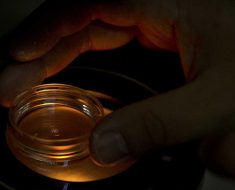In warm sea water, you will feel especially comfortable: Vibrios. The salt-loving bacteria can multiply at a water temperature of 20 degrees is good for bathers in the Baltic sea the risk of infection increases. FOCUS Online explains how you can recognize an infection and what you should do.
In Germany, on the Baltic sea to increased Vibrio occurrence. The “Ostsee-Zeitung” reported that the bacteria have called in this summer, already one fatality, four other infections were of the state office for health and social Affairs is known. In the past year, 2018 18 diseases were counted, three of which were fatal.
Vibrios are natural inhabitants of the seas. The temperature of the water rises above a longer period of time in excess of 20 degrees, can reproduce the rod bacteria optimally. You are at the health risk to bathers people.
Vibrios are a hazard for weakened people
Three species of the genus Vibrio are pathogens for humans especially relevant. The most prominent of V. cholerae that causes the Cholera, which does not occur in German waters usually is. V. parahaemolyticus and V. vulnificus on hold, however, in the local seas, the Baltic sea is one of the strongest of the V. vulnificus risk areas.
In particular, a weakened immune system, people with pre-existing conditions such as Diabetes or liver disease are at risk for contact with the bacteria serious infections involve. Infections caused by Vibrios are rare, it is, however, however, is the course of the disease is often difficult.
Clinical picture depending on the type of the recording
Infection with Vibrios in two different ways. The clinical picture depends on how the pathogen were recorded.
Take the Vibrios oral, so by swallowing contaminated water or contaminated food consumed, it comes to symptoms in the gastro-intestinal tract. Typically eight to 24 hours after the contact, vomiting, or diarrhea. In healthy people, the stomach flu is usually harmless and disappears after three days. In elderly or debilitated patients may occur within a few hours after the recording of the pathogen to a Sepsis with multi-organ failure.
Infection with Vibrios on the stomach plays on the Baltic sea, however, a subordinate role. You do not relates primarily to the consumption of cooked sea animals in warmer climates.
Open wounds as a risk factor
For Vibrio infections in the Baltic sea area skin injuries and open wounds are mainly as a portal of Entry is relevant. Even the smallest injury to the skin, comply with V. vulnificus to enter the body. In General, the incubation period for the infection is just a few hours. In the case of immune-weak people can spread the superficial infection and to tissue death, necrosis, or blood-poisoning from the lead.
In more than half of the cases of infection with V. vulnificus is fatal. Symptoms occur after bathing in warm waters such as
- Fever and chills,
- Diarrhea or
- Wound infections with swelling, redness, and blisters, should act Affected quickly.
The Robert Koch Institute advises (p. 277) therefore, at-risk groups to avoid contact with warm seawater if you have open wounds. A fresh Tattoo is a possible portal of Entry for the pathogen.
Quick treatment is crucial
After the contact with the Vibrio bacteria in the wound infection is getting worse rapidly. This means that When infection is suspected, immediately to the doctor. The bacteria enter the bloodstream, causing blood poisoning, the Survival rate is only 50 percent. Within 48 hours can lead to death. A quick anti-bacterial treatment is therefore crucial.
Already in the case of suspected infection with V. vulnificus patients should get antibiotics prescribed. The necrosis has advanced, needs to be removed the infected tissue. In the worst case, Amputation of the affected limb is necessary.
Infection with V. vulnificus in Germany rare
The rarity of Vibrio infections is your risk. Doctors do not involve them in your everyday diagnosis often. Occur after swimming Sympotme, you should highlight as a risk the patient to the doctor, therefore, previous contact with warm water. This can search specifically for V. vulnificus.





